Microsoft Multiplan
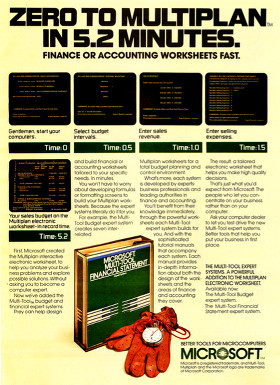
Microsoft Multiplan advertisement from May 1983 BYTE
Multiplan (sometimes called the Multiplan Electronic Worksheet) was a “second generation” spreadsheet, designed to compete with VisiCalc, the original (and incredibly popular) spreadsheet program. Multiplan was written by Douglas Klunder under the direction of Charles Simonyi, the head of Microsoft’s new application software group.
Originally code-named “EP” (for “Electronic Paper”), Multiplan was written to use a very clever p-code compiler system created by Richard Brodie. This p-code system, which was also used later by Microsoft Word, allowed Microsoft to target Multiplan to a huge number of different 8-bit and 16-bit computer systems. (Charles Simonyi once estimated that Multiplan was available for 100 platforms.)
TRS-80 Multiplan
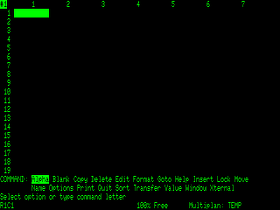
Multiplan for Model 4 TRSDOS
- Model II/12 Multiplan (catalog number 26-4580) for $249.00
- Model 16/Tandy 6000 multi-user Multiplan (catalog number 26-6480) for $349.00
- Model 4 Multiplan (catalog number 26-1530) for $199.00
- Model 2000 Multiplan (catalog number 26-5311) for $249.00
- Model 1000 Multiplan (catalog number 25-1152) for $195.00
- Model 1000/1200/2000/3000 Multiplan (catalog number 25-1163) for $195.00
- Model 100 Multiplan option ROM (catalog number 26-3829) for $149.95
Some articles refer to a Model III version of Multiplan, but no such version seems to have existed.
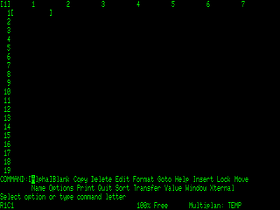
Multiplan for Model 4 CP/M
- Tandy 200 Multiplan was included in the Tandy 200 ROM
- Tandy 600 Multiplan was included in the Tandy 600 ROM (along with Microsoft Word and other tools) as part of Microsoft Works
Model II and Model 4 CP/M users could also run CP/M versions of Multiplan.
The various TRS-80 versions of Multiplan used different file formats, but data could be shared by importing and exporting in the SYLK format. Many modern spreadsheets, including Microsoft Excel and LibreOffice, can still import SYLK files.
“Personal Productivity Tool”
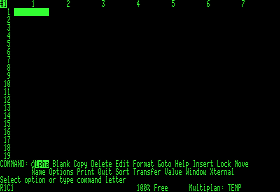
Multiplan for the Apple II
Multiplan is an electronic worksheet — a large grid of entries, each of which can be made up of words, titles, numbers, or formulas. You can set up the Multiplan worksheet with titles and numbers. Moreover, Multiplan can replace your pen and paper and your calculator because Multiplan can perform the calculations for you.
Model 4 Multiplan was a very powerful spreadsheet, with more features than VisiCalc. The main criticism of the Model 4 version of Multiplan was that it was slow. As the otherwise favorable review in the June 1984 issue of 80 Micro stated: “Multiplan for the Model 4 is no speed demon.” Although Multiplan had more features, many people preferred VisiCalc because it was noticeably faster.
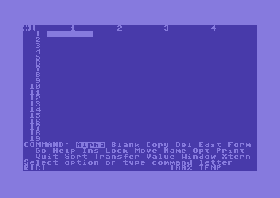
Multiplan for the Commodore 64
But Multiplan was a popular program and many people installed speed-up boards to make it faster. It remained the most powerful Model 4 spreadsheet available until David Goben released BCX in 1991.
Legacy
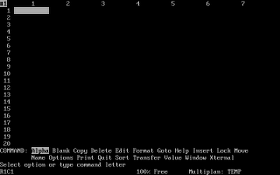
Multiplan for the IBM PC
But Lotus 1-2-3 turned out to be Multiplan’s real spreadsheet competition. Lotus 1-2-3 dominated the IBM PC spreadsheet market and Multiplan was never able to challenge it. The reasons why were debatable, but the consensus within Microsoft was that targeting Multiplan for so many computers, particularly 8-bit computers, had been a mistake. As Charles Simonyi said in an interview:
We were betting on the wrong horse — the mixed market with a variety of systems, instead of the right horse, which happened to be also ourselves, namely MS-DOS.
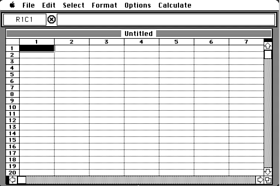
Multiplan for the Apple Macintosh
In a 1993 interview with the Smithsonian Institution, Bill Gates described Multiplan as a “great product” but said the 8-bit compatibility had been a mistake:
Multiplan, targeting the 8-bit machines instead of just relying on the next generation to come, the IBM PC generation, that was a huge error. When we talk about, “Are we aiming too low, in terms of system requirements, we often think, is this another case like Multiplan?”
But that “error” with Multiplan influenced the strategy Bill Gates chose to use for Excel:
There was a question of whether to do it in the character-mode environment, or whether to move up to the next generation, which was graphical. And we said, “Okay, we’ll let them dominate the DOS-character world. We are going after Mac and Windows. We are going to be a generation ahead.”
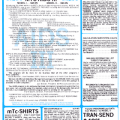
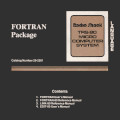
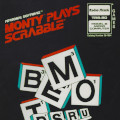
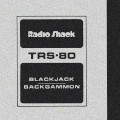










David Sutherland says:
Another excellent article. Thanks Mr. Reed for the research and work that went into this. The “another case like Multiplan” Gates quote is especially fascinating and demonstrates the significant role this title held.
David Sutherland says:
I had not heard of Goben’s BCX. Was it sold in Radio Shack stores? Was it very popular?
Matthew Reed (TRS80.org) says:
BCX was sold through Computer News 80. David Goben wrote three spreadsheet programs of increasing capabilities: BusyCalc, BCX, and BCX2.
Thomas Nickels says:
First Used Multiplan Program in 1984. I was running a small business and configured the program for bookkeeping and accounting. Worked Great. Used it for 10 years until 1994 when my ATT Ms Dos based computer finally died. I didn’t know it was a forerunner of Excel.
Alexandre MONTARON says:
*News* I’ve patched Multiplan 1.06 for CP/M last year into a (new) colorized version – Yes! It’s 4 colors at most – It’s there: http://canal.chez.com/CPM/mp-vt100.htm (Snapshot at bottom)
Hope that will be of your interest…
Alex.